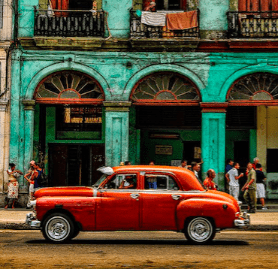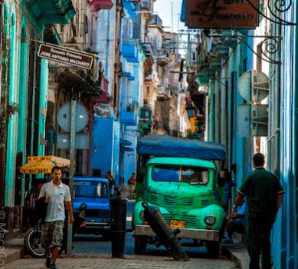
"And the day came when the risk to remain tight in a bud was more painful than the risk it took to blossom. " -Anaïs Nin
This is the story of a Cuban refugee & her return home.
Cuba. Los Angeles. Life.
Arleen's Blog
There are no published blog posts yet.campaign: research trip
Cuba, May 2016
CUBA
at a glance

sounds
music of Cuba
The music of Cuba, including its instruments, performance and dance, comprises a large set of unique traditions influenced mostly by west African and European (especially Spanish) music. Due to the syncretic nature of most of its genres, Cuban music is often considered one of the richest and most influential regional musics of the world. For instance, the son cubano merges an adapted Spanish guitar (tres), melody, harmony, and lyrical traditions with Afro-Cuban percussion and rhythms. Almost nothing remains of the original native traditions, since the native population was exterminated in the 16th century.

sites
fascinating and historical
Cuba’s history has been one of revolutions, dictatorships and hostility towards and from other countries, but one thing that could never be said about it is that Cuban history was boring. Even up until a few decades ago, interesting things have been happening in Cuba, and while not all of it was pleasant for Cuba's people, for a historian they make for a great read. Even the shortest trip to Cuba reveal countless historical sights that commemorate the most important historical events in the country. If you are interested in history, or if you simply want to visit some fascinating sights, then you should definitely check out some of the most interesting historical sites in Cuba (site 18 " albeit partisan", but still part of history).

people
Cubanos
Cubans or Cuban people (Spanish: Cubanos) are the inhabitants or citizens of Cuba. Cuba is a multi-ethnic nation, home to people of different ethnic and national backgrounds. The majority of Cubans descend from Spaniards and West African ancestors.. The Institute of Cuban and Cuban-American Studies at the University of Miami says 62% are black. The percentage of Afro-Cubans on the island increased after the 1959 revolution led by Fidel Castro due to mass migration from the island of largely white Cuban professional class (5). A small percentage of Afro-Cubans left Cuba, mostly for the United States, (particularly Florida), where they and their U.S.-born children are called Cuban Americans, (source Wikipedia)

life
daily life in Cuba
Before the revolution, Cuba was one of the most advanced and successful countries in Latin America. Cuba's capital, Havana, was a "glittering and dynamic city", however, behind the "glitter" was a significant amount of disparity between the working class and the wealthy. The country's economy in the early part of the century, fueled by the sale of sugar to the United States, had grown wealthy. Cuba ranked 5th in the hemisphere in per capita income, 3rd in life expectancy, 2nd in per capita ownership of automobiles and telephones, and 1st in the number of television sets per inhabitant. Cuba's literacy rate, 76%, was the fourth highest in Latin America. Cuba also ranked 11th in the world in the number of doctors per capita. Several private clinics and hospitals provided services for the poor.
contact
Arleen
Copyright 2016. Arleen Milian







